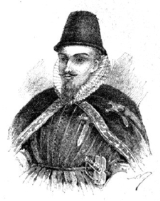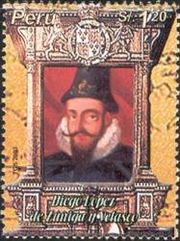
Diego López de Zúñiga y Velasco
Encyclopedia
Diego López de Zúñiga y Velasco, 4th Count of Nieva (ca. 1510, —February 20, 1564, Lima
, Peru
) was the sixth viceroy of Peru, from April 17, 1561 to his death on February 20, 1564.
, and from 1553 to 1559, governor of Galicia. He was named Peruvian viceroy in late 1560 by King Philip II
to replace Andrés Hurtado de Mendoza, 3rd Marquis of Cañete
, who had been recalled. López de Zúñiga arrived in Lima and took up the office on February 20, 1561. After his arrival in Peru but before reaching the capital, he sent impertinent messages to his predecessor, just before the death of the latter. Some said that the recall and the insulting communications from López de Zúñiga had brought about the death of Hurtado de Mendoza.
 On December 14, 1561 he ordered Gómez de Tordoya to explore the River Tono, and on December 24, 1561 he commissioned Juan Nieto to conquer the territory of Camaná
On December 14, 1561 he ordered Gómez de Tordoya to explore the River Tono, and on December 24, 1561 he commissioned Juan Nieto to conquer the territory of Camaná
.
In 1562 the city of Santiago del Estero
(today in Tucumán province
, Argentina
) was founded by Francisco de Aguirre
on orders of the viceroy. The following year the Audiencia of Quito
was established. López de Zúñiga also founded the city of Safia (Santiago de Miraflores) and directed Cristóbal de Valverde to found San Gerónimo de Ica. He founded the town of Arnedo (now Chancay
) with the intention of moving the University of San Marcos there, for its tranquility.
He began the construction of the entrances that surround the Plaza Mayor in Lima. These were destroyed in the earthquake of October 20, 1687
, but later rebuilt.
In addition, he directed the separation of the diocese of Chile from that of Peru. He organized and improved schools for the sons of Indigenous leaders. Doña Ana de Solórzano founded a school for poor girls in 1562. López de Zúñiga favored the monasteries, ordered the construction of an aqueduct to bring potable water to Lima, and passed laws for the improvement of the government of the colony. During his term in office he sent 651,000 ducats to the royal treasury in Spain. He was the first viceroy of Peru to introduce the pomp of a viceregal court, with much attention paid to details of etiquette, ceremony and precedence.
There was a single witness to these events, a young man taking the air on the balcony of the Zarate family residence nearby. This man was thought to be Pedro de Zarate. He called to his slaves, and together with them he went to investigate the incident. When they arrived, they found the victim dead and the assailants gone. And they discovered that the victim was in fact Viceroy López de Zúñiga y Velasco, apparently returning from a late-night tryst. Zarate was the son of one of the judges of the Audiencia of Lima, and this court was assembled to decide what action to take. The decision was made to move the body to the viceregal palace, and to announce that the viceroy had died of a sudden attack of apoplexy.
This was done, but rumors circulated concerning the other explanation of the viceroy's death. It was said that the woman involved was Catalina López de Zúñiga, a cousin of the viceroy and wife of Rodrigo Manrique de Lara. The later was said to have hired the assassins.
This account is the one currently accepted, but it is not certain that it is true. The viceroy was known for his affairs, so perhaps his reputation alone generated the rumors. At least one medical paper (see the fourth reference below) claims to have found evidence that the viceroy died of a stroke, presumably in his palace.
The body of López de Zúñiga y Velasco was interred in the church of San Francisco, and later transferred to Spain.
Lima
Lima is the capital and the largest city of Peru. It is located in the valleys of the Chillón, Rímac and Lurín rivers, in the central part of the country, on a desert coast overlooking the Pacific Ocean. Together with the seaport of Callao, it forms a contiguous urban area known as the Lima...
, Peru
Peru
Peru , officially the Republic of Peru , is a country in western South America. It is bordered on the north by Ecuador and Colombia, on the east by Brazil, on the southeast by Bolivia, on the south by Chile, and on the west by the Pacific Ocean....
) was the sixth viceroy of Peru, from April 17, 1561 to his death on February 20, 1564.
Early career
López de Zúñiga was a knight of the military Order of SantiagoOrder of Santiago
The Order of Santiago was founded in the 12th century, and owes its name to the national patron of Galicia and Spain, Santiago , under whose banner the Christians of Galicia and Asturias began in the 9th century to combat and drive back the Muslims of the Iberian Peninsula.-History:Santiago de...
, and from 1553 to 1559, governor of Galicia. He was named Peruvian viceroy in late 1560 by King Philip II
Philip II of Spain
Philip II was King of Spain, Portugal, Naples, Sicily, and, while married to Mary I, King of England and Ireland. He was lord of the Seventeen Provinces from 1556 until 1581, holding various titles for the individual territories such as duke or count....
to replace Andrés Hurtado de Mendoza, 3rd Marquis of Cañete
Andrés Hurtado de Mendoza, 3rd Marquis of Cañete
Andrés Hurtado de Mendoza y Cabrera, 3rd Marquis of Cañete was a Spanish military officer and, from June 29, 1556 to his death on March 30, 1561, the fifth Viceroy of Peru.-Origins and military career:...
, who had been recalled. López de Zúñiga arrived in Lima and took up the office on February 20, 1561. After his arrival in Peru but before reaching the capital, he sent impertinent messages to his predecessor, just before the death of the latter. Some said that the recall and the insulting communications from López de Zúñiga had brought about the death of Hurtado de Mendoza.
Viceroy of Peru

Camaná
Camaná is a coastal town in the Arequipa Region in southern Peru. It is the capital of Camaná Province and Camaná District. With its sandy beaches, it is a very popular beach resort with local Peruvians visiting mostly from Arequipa during the summer months...
.
In 1562 the city of Santiago del Estero
Santiago del Estero
Santiago del Estero is the capital of Santiago del Estero Province in northern Argentina. It has a population of 244,733 inhabitants, making it the twelfth largest city in the country, with a surface area of 2,116 km². It lies on the Dulce River and on National Route 9, at a distance of...
(today in Tucumán province
Tucumán Province
Tucumán is the most densely populated, and the smallest by land area, of the provinces of Argentina. Located in the northwest of the country, the capital is San Miguel de Tucumán, often shortened to Tucumán. Neighboring provinces are, clockwise from the north: Salta, Santiago del Estero and...
, Argentina
Argentina
Argentina , officially the Argentine Republic , is the second largest country in South America by land area, after Brazil. It is constituted as a federation of 23 provinces and an autonomous city, Buenos Aires...
) was founded by Francisco de Aguirre
Francisco de Aguirre (conquistador)
Francisco de Aguirre was a Spanish conquistador who participated in the conquest of Peru, Bolivia, Chile and Argentina.-Early life:...
on orders of the viceroy. The following year the Audiencia of Quito
Quito
San Francisco de Quito, most often called Quito , is the capital city of Ecuador in northwestern South America. It is located in north-central Ecuador in the Guayllabamba river basin, on the eastern slopes of Pichincha, an active stratovolcano in the Andes mountains...
was established. López de Zúñiga also founded the city of Safia (Santiago de Miraflores) and directed Cristóbal de Valverde to found San Gerónimo de Ica. He founded the town of Arnedo (now Chancay
Chancay
Chancay is a small city in the Lima Region of Peru. Its population is 26,958....
) with the intention of moving the University of San Marcos there, for its tranquility.
He began the construction of the entrances that surround the Plaza Mayor in Lima. These were destroyed in the earthquake of October 20, 1687
1687 Peru earthquake
The 1687 Peru earthquake occurred at 11:30 UTC on October 20. It had an estimated magnitude of 8.4–8.7 and caused severe damage to Lima, Callao and Ica. It triggered a tsunami and overall about 5,000 people died.-Tectonic setting:...
, but later rebuilt.
In addition, he directed the separation of the diocese of Chile from that of Peru. He organized and improved schools for the sons of Indigenous leaders. Doña Ana de Solórzano founded a school for poor girls in 1562. López de Zúñiga favored the monasteries, ordered the construction of an aqueduct to bring potable water to Lima, and passed laws for the improvement of the government of the colony. During his term in office he sent 651,000 ducats to the royal treasury in Spain. He was the first viceroy of Peru to introduce the pomp of a viceregal court, with much attention paid to details of etiquette, ceremony and precedence.
Death
On February 1, 1564 he issued an edict setting a curfew for 10 p.m. in the city of Lima. On the following February 20, at midnight, four figures with their faces completely covered were seen violating the curfew. They entered the street of Trapitos and took up positions outside one of the houses there. At night this street was one of the most deserted in the city. The block in question was made up of four houses, none of which opened on Trapitos. There were no doors, but there were some balconies overlooking the street. Shortly after the arrival of the masked men, a rope ladder was thrown down from one of these balconies, and a man wrapped in a cape began to descend. Just before he reached the street, the four men lying in wait began to beat him with sandbags.There was a single witness to these events, a young man taking the air on the balcony of the Zarate family residence nearby. This man was thought to be Pedro de Zarate. He called to his slaves, and together with them he went to investigate the incident. When they arrived, they found the victim dead and the assailants gone. And they discovered that the victim was in fact Viceroy López de Zúñiga y Velasco, apparently returning from a late-night tryst. Zarate was the son of one of the judges of the Audiencia of Lima, and this court was assembled to decide what action to take. The decision was made to move the body to the viceregal palace, and to announce that the viceroy had died of a sudden attack of apoplexy.
This was done, but rumors circulated concerning the other explanation of the viceroy's death. It was said that the woman involved was Catalina López de Zúñiga, a cousin of the viceroy and wife of Rodrigo Manrique de Lara. The later was said to have hired the assassins.
This account is the one currently accepted, but it is not certain that it is true. The viceroy was known for his affairs, so perhaps his reputation alone generated the rumors. At least one medical paper (see the fourth reference below) claims to have found evidence that the viceroy died of a stroke, presumably in his palace.
The body of López de Zúñiga y Velasco was interred in the church of San Francisco, and later transferred to Spain.

